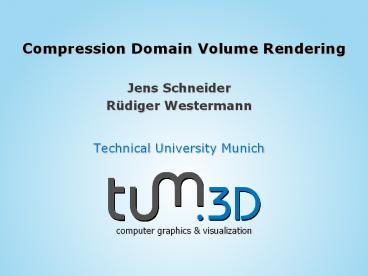Compression Domain Volume Rendering - PowerPoint PPT Presentation
1 / 25
Title: Compression Domain Volume Rendering
1
Compression Domain Volume Rendering
- Jens Schneider
- Rüdiger Westermann
- Technical University Munich
2
Motivation
- Need to deal with data of increasing size
- Large-scale
- Multi-dimensional
- Multi-parameter
- Increasing problems
- Compression
- Representation
- Rendering
- We will adress all three problems!
3
Talk Outline
- The Approach Vector Quantization
- Contributions
- Quality and speed
- Hierachical encoding
- PCA-Split
- Progressive encoding of time-resolved data
- Multi-dimensional data
- Vectors of arbitrary length
- Rendering from compressed data
- GPU-based decoding and rendering
- Per-fragment evaluation
- Interactive framerates
4
Talk Outline
- The Application Volume Rendering
- Large-scale volumetric data sets
- Time-varying sequences
1.4 GB / 20 fps
16 MB / 14 fps 0.78 MB / 11 fps
70 MB / 24 fps
5
Vector Quantization
6
Vector Quantization
- LBG-Algorithm
- Linde, Buzo and Gray 1980
- Iterative refinement of a previous Codebook
- Sensitive to quality of first Codebook
- Usually computationally expensive
- Speed-Up possible (and necessary)
- Partial searches
- Fast searches
- Better initial Codebook (i.e. PCA-Splits)
- LBG-Algorithm can be fast!
7
Vector Quantization
- The PCA-Split
- Lensch et.al. 2001 BRDF Compression
- Covariance analysis to find optimal splitting
plane - Cut a cluster of input vectors in two by this
plane. - Plane is given by centroid of current set and
largest Eigenvector ( normal) of the
Auto-Covariance Matrix
8
Vector Quantization
- LBG as PCA post-processing
- Increases fidelity
- Leads to stable Voronoi-Regions
- Only a few steps are necessary
- Great speed-up compared to LBG only!
- A series of LBG steps, codebook from last slide
9
Example
- Full-color confocal microscopy scan, 5122x32xRGB?
10
Hierarchical Vector Quantization
Laplace Decomposition
11
Hierarchical Vector Quantization
12
Hierarchical Vector Quantization
- Output
- One RGB Index-Volume
- Two Codebooks
RGB Index-Volume ? 3D Texture Codebooks ? 2D
?-Textures
13
Example
- Visible Human (Male), RGB slice 2048x1216
- Compression took 10.0 seconds, PSNR 34.72dB
Original (7.1MB)
Compressed (285KB)
14
Timings
- Reference System P4 2.8GHz, 1GB memory
- VHP Slice, 2048x1216 RGB 10.0 sec
- Engine 2562x128 CT-Scan 19.0 sec
- Skull 2563 CT-Scan 50.6 sec
- Vortex Sequence, 1283x100 13 (5) min
- Shockwave Sequence, 2563x89 29 (13) min
15
Rendering
- GPU-based decoding
- Indices stored in 3D RGB-texture (3/64th original
size) - Decode index per block ? dependent fetch
- Decode adress per block ? 43 adress texture
16
Rendering
- Render 3D index and adress texture
- Nearest neighbor interpolation for both
- GL_REPEAT for adress texture
- Per-fragment decoding
- Decode detail components and dependent fetch
- Add the details to average component (Red
channel) - Lookup result in 1D RGB? transfer function
- Problem
- Complex fragment shader slows down rendering
17
Rendering
- Solution Deferred Fragment Processing
- Avoid decoding in empty regions. Empty means
- a) ? -Transfer function maps 0 ? 0.
- Check on CPU
- Switch between two possible rendering modes
- b) Average value is 0 (Red channel)
- Check in a first, simple fragment program
- Fragments depth value is set accordingly
- Second pass discard (early Z-Test) or render
fragment - Full decoding only performed in second pass
18
2562x128 Engine CT Scan
- 19.0 seconds, PSNR 36.17dB (P4 2.8GHz)
Original (8MB) 19 fps
Compressed (402KB) 12 fps
19
2563 Skull CT Scan
- 50.6 seconds, PSNR 35.35dB (P4 2.8GHz)
Original (16MB) 14 fps
Compressed (780KB) 11 fps
20
Time-resolved Sequences
- Exploit temporal coherences during compression
- Group of Frames (GOF)
- First frame in a GOF
- PCA-Split followed by LBG-Refinement
- Other frames
- LBG-refinement of last Index-Volume and Codebook
- Result
- Great speed-up (factor 2 to 3)
- Very large GOFs possible (64 frames)
- Virtually same fidelity as frame-by-frame
21
1283x100 Vortex-Simulation
- 5 minutes, PSNR 34.43dB (P4 2.8 GHz)
Original (200MB) - 28 fps
Compressed (11MB) - 16 fps
22
2563x89 Shockwave-Sequence
- 13 minutes, PSNR 51.36dB (P4 2.8 GHz)
Original (1.4GB) - 20 fps
Compressed (70MB) - 24 fps
23
Conclusions
- Compression ratios of approx. 201
- Interactive rendering possible
- Easy random access to each frame
- Wide variety of data sets handled
- Currently only nearest neighbor interpolation
- Mainly limited by performance / instruction
count. - Tri-linear interpolation can be done on newer
GPUs!
24
Online Demo
- Demo-machine with ATi 9800 Pro
- kindly provided by ATi
25
Thank You!
- Questions ?






























